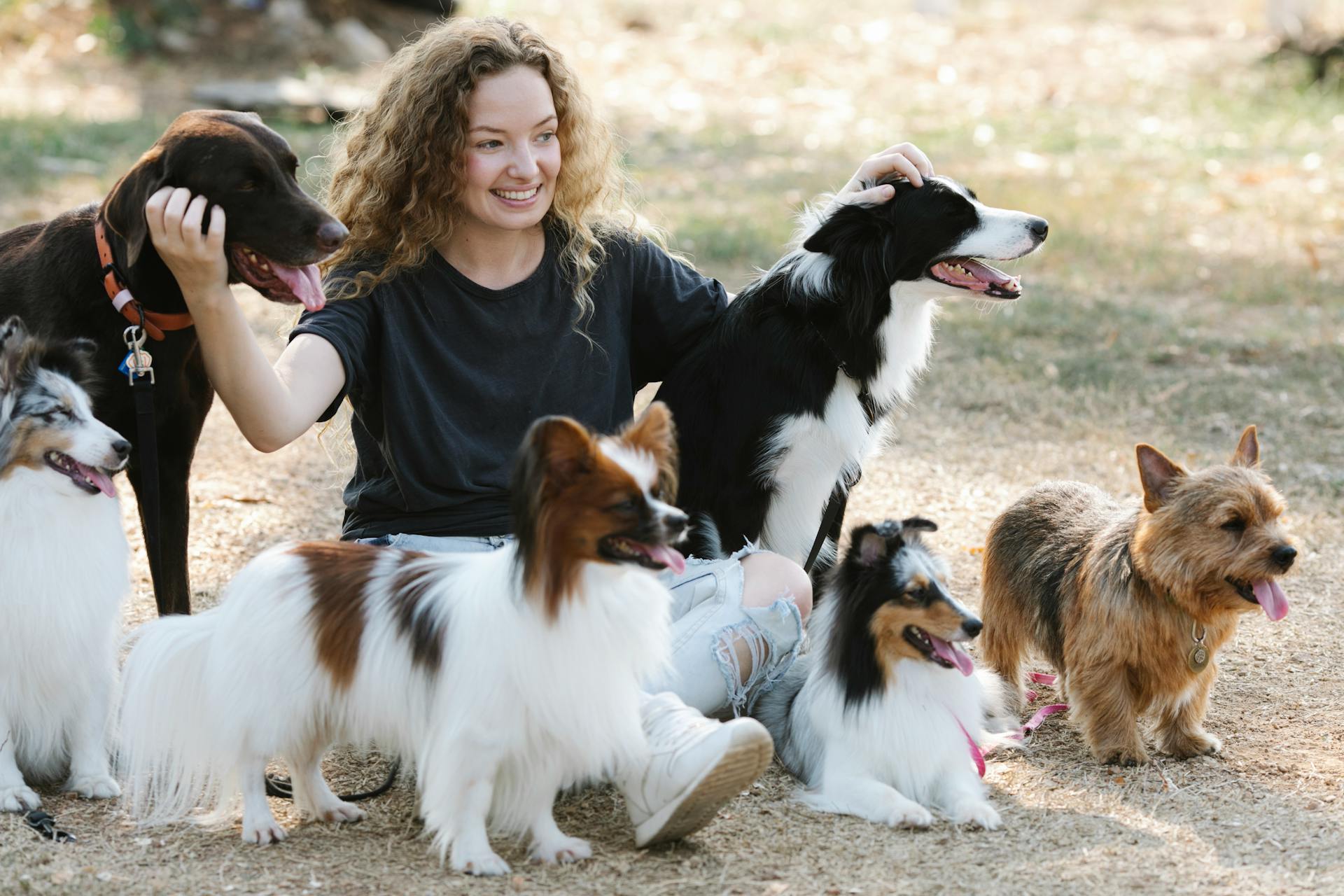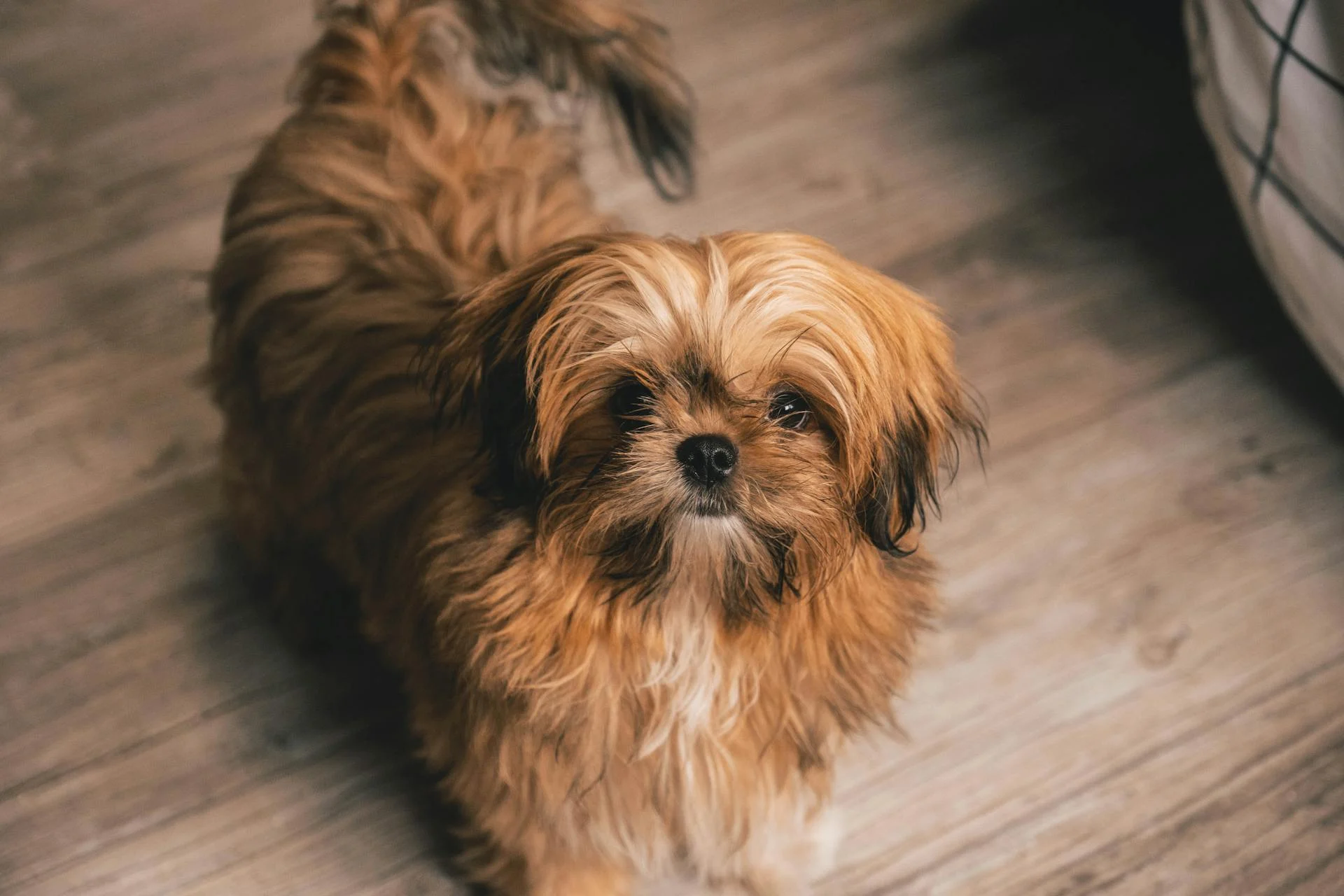
Shih Tzus are prone to hot spots, which are painful and irritating skin lesions that can quickly become infected if not properly cared for.
Hot spots can be caused by skin allergies, fleas, or even a simple scratch that becomes infected.
Preventing hot spots is key, and regular grooming is essential to keep your Shih Tzu's coat clean and healthy.
Regular nail trimming, ear cleaning, and brushing can help reduce the risk of hot spots.
By being aware of the causes and taking preventative measures, you can help keep your Shih Tzu comfortable and happy.
Additional reading: Miniature Schnauzer Skin Problems
What Are Hot Spots?
Hot spots are areas of infected, inflamed skin that are very uncomfortable for your dog. They can get moist or itchy and even ooze.
Dog hot spots are caused by a condition called acute moist dermatitis. This results from constant licking, biting, and scratching of one area, leading to inflammation.
Hot spots are often initiated by a rapid increase of bacteria, usually Staphylococcus pseudintermedius, on the skin surface. This is worsened by self-trauma to the area.
Dog breeds with thick, heavy, dense hair coats, such as Golden and Labrador Retrievers, Collies, and German Shepherds, are more likely to develop hot spots.
For more insights, see: Dog Dandruff or Flea Eggs
Causes and Prevention
Hot spots on Shih Tzus can be caused by food allergies, which account for as many as 50% of cases, according to recent estimates. Fleas, insect bites, and parasites like ringworm and scabies mites are also common culprits.
Other potential causes include seasonal or environmental allergies, yeast infections, ear infections, and anal gland inflammation. Excessive licking due to stress or boredom can also lead to hot spots. Any underlying condition that triggers excessive licking, scratching, or moisture build-up can cause hot spots on Shih Tzus.
Preventing hot spots requires attention to grooming, bathing, and flea control. Regular grooming can help prevent mats and dirty coats, which can contribute to hot spots. Keeping your Shih Tzu's coat completely dry after bathing or swimming is also essential. Consider using fatty acid supplements like fish oil, which contain anti-inflammatory properties and promote a healthy skin barrier.
Expand your knowledge: Trim a Shih Tzu
Causes to Watch Out For
Food allergies can account for as many as 50% of dogs' hot spots, so it's essential to talk to your vet to determine what's bothering your pup.

Fleas, insect bites, and parasites like ringworm and scabies mites can also trigger hot spots.
Seasonal or environmental allergies, yeast infections, ear infections, and anal gland inflammation are other common causes.
Excessive licking due to stress or boredom can lead to hot spots, as can a matted or dirty coat.
Moisture trapped within the coat, from bathing or swimming, can also cause hot spots.
Here are some common causes of hot spots on dogs to watch out for:
- Flea bites
- Insect bites
- Parasitic skin diseases
- Ear infections
- Anal gland issues
- Excessive licking due to stress or boredom
- Moisture trapped within the coat
- Atopic dermatitis
- Excessive moisture from frequent swimming
- Contact sensitivities
- Pain from dog anal gland issues, dental disease, muscle injuries, or other uncomfortable medical problems
Hot spots can occur anywhere on a dog's body that they can lick, chew, rub, and scratch, but common locations include the ears, head, tail base, and around the anus.
Mange
Mange is a skin condition caused by mites, which can lead to nasty hot spots and sores on a dog's skin.
These sores can release secretions that cause a strong, unpleasant odor.
Mange can be contagious, specifically scabies or sarcoptic mange, which can even be transmitted to humans.
Black mange, on the other hand, is not contagious, but it is genetic.
Mange can be a serious issue for dogs, and it's essential to learn more about it and how to help a dog with it.
Discover more: Allergies on Dogs Belly
Diagnosis and Treatment
Diagnosis of Shih Tzu hot spots typically involves a physical exam to assess the extent of the lesion and identify any underlying causes. Your veterinarian may perform a skin surface cytology to check for bacteria and skin scrapings to look for parasites.
To diagnose the underlying cause of the hot spot, your vet may recommend additional tests such as skin cytology, skin biopsy, or ear cytology.
A full physical exam is crucial to diagnose the underlying cause of the hot spot. Your vet will clip the hair in the affected area to see the full extent of the hot spot and improve air flow and access to the skin.
Here are some common underlying causes of hot spots in Shih Tzus:
- Ear infections
- Allergies
- Flea infestations
- Food allergies
- Ear wax buildup
Treatment for hot spots in Shih Tzus typically involves removing the grouping of bacteria from the skin surface, clipping and thoroughly cleaning the affected area, and applying topical treatments to alleviate itching and inflammation.
What Does a Dog Look Like?

A hot spot on a dog can look like a small, red patch of skin, but it can quickly become enlarged and develop into a more severe condition.
The affected area may scab, ooze discharge, and in severe cases, bleed. Swelling, hair loss, and pain to the touch are also common signs.
Hot spots can occur anywhere on a dog's body, but they're especially prevalent in moist areas prone to bacterial infection.
The appearance and size of hot spots vary by location, which can include the neck, face, hips, or limbs.
A dog's dense haircoat can hide a hot spot at first, but it may become intensely red, moist, and covered by matted or crusted fur as the condition progresses.
On the other hand, mild hot spots on dogs with thinner fur may appear as a faint red skin with some hair loss, and the affected area is usually flat, dry, and non-flaky.
Worth a look: Red Shih Tzu Puppy
How Are Diagnosed?
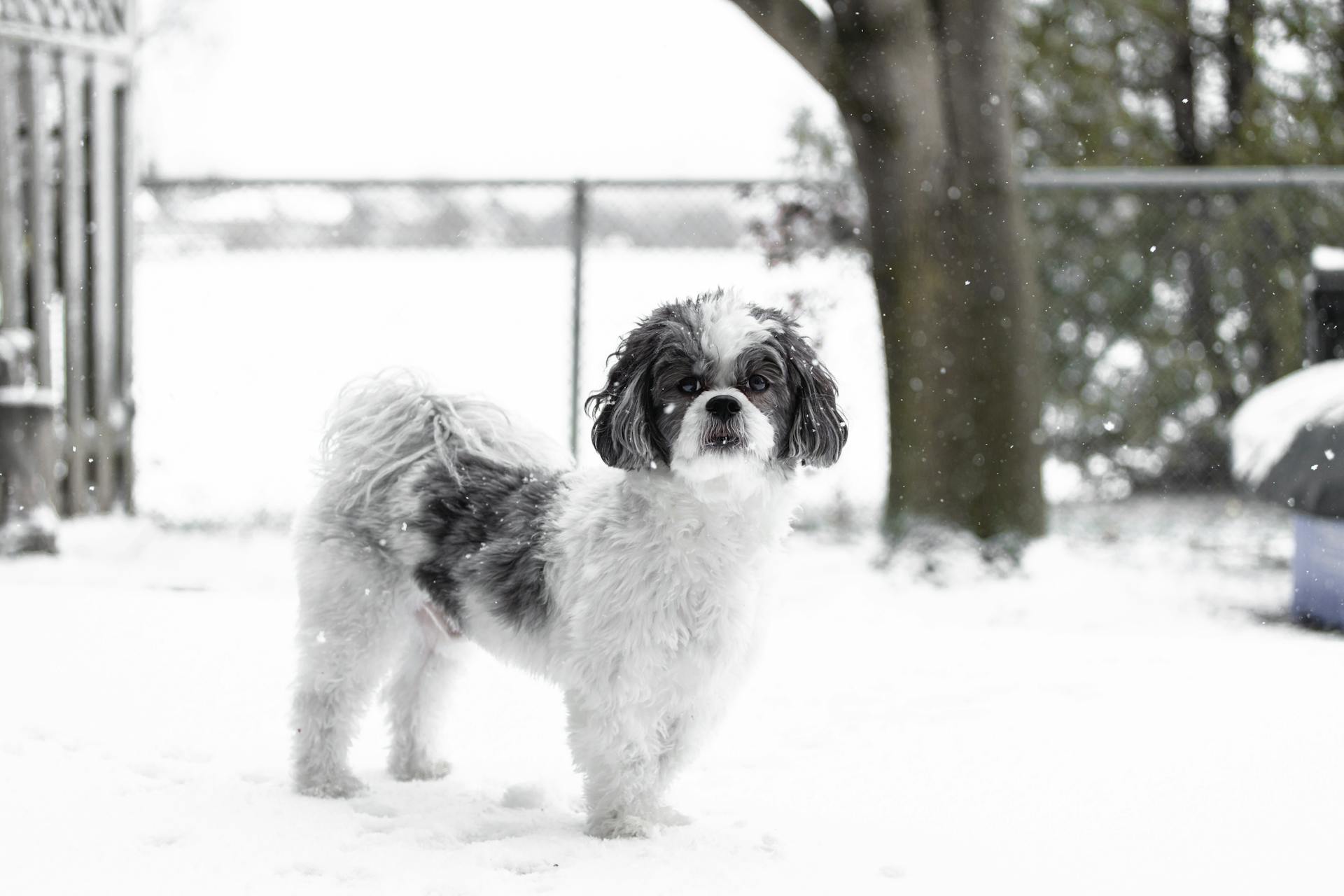
Diagnosis of hot spots is relatively straightforward, thanks to their classic appearance. Your vet may not need to do any diagnostic testing beyond a physical exam.
However, in some cases, your vet may recommend additional testing such as skin cytology or skin biopsy to rule out other conditions.
Skin cytology involves collecting cells and material from the surface of the lesion and examining them under the microscope. This can help identify the presence of bacteria or other parasites.
A skin biopsy can help rule out other conditions like tumors or furunculosis in dogs. It involves sampling a small portion of the skin and examining it under the microscope.
Your vet may also recommend other tests to help pin down the inciting factor for the hot spot, such as an ear cytology, orthopedic exam, or oral exam.
To make a proper diagnosis, your vet will probably start by clipping the hair in the affected area. This allows them to see the full extent of the hot spot and improve air flow and access to the skin.
In some cases, dogs may require short-acting sedation to allow safe and comfortable clipping due to the painful nature of hot spots.
Here's an interesting read: Shih Tzu Skin Issues
What Is Treatment?
Treatment for hot spots on dogs involves addressing the underlying cause of the irritation. Your veterinarian will need to identify the underlying cause to treat it effectively and prevent it from recurring.
The first step in treatment is to remove the grouping of bacteria from the skin surface, which may involve clipping and thoroughly cleaning the affected area with a chlorhexidine scrub. This is typically done by your veterinarian.
Topical treatment is often the primary treatment for hot spots, and may include a drying agent, such as 2% aluminum acetate, or a 1% hydrocortisone with aluminum acetate solution applied topically two to three times a day until the lesion is healed.
Systemic medications may be prescribed by your veterinarian in some cases, such as if folliculitis is present.
To soothe the hot spot, apply a cool wash cloth or compress to relieve irritation, before patting it dry. This can help reduce the itching and inflammation associated with hot spots.
Take a look at this: Shih Tzu Skin Problems Black Spots
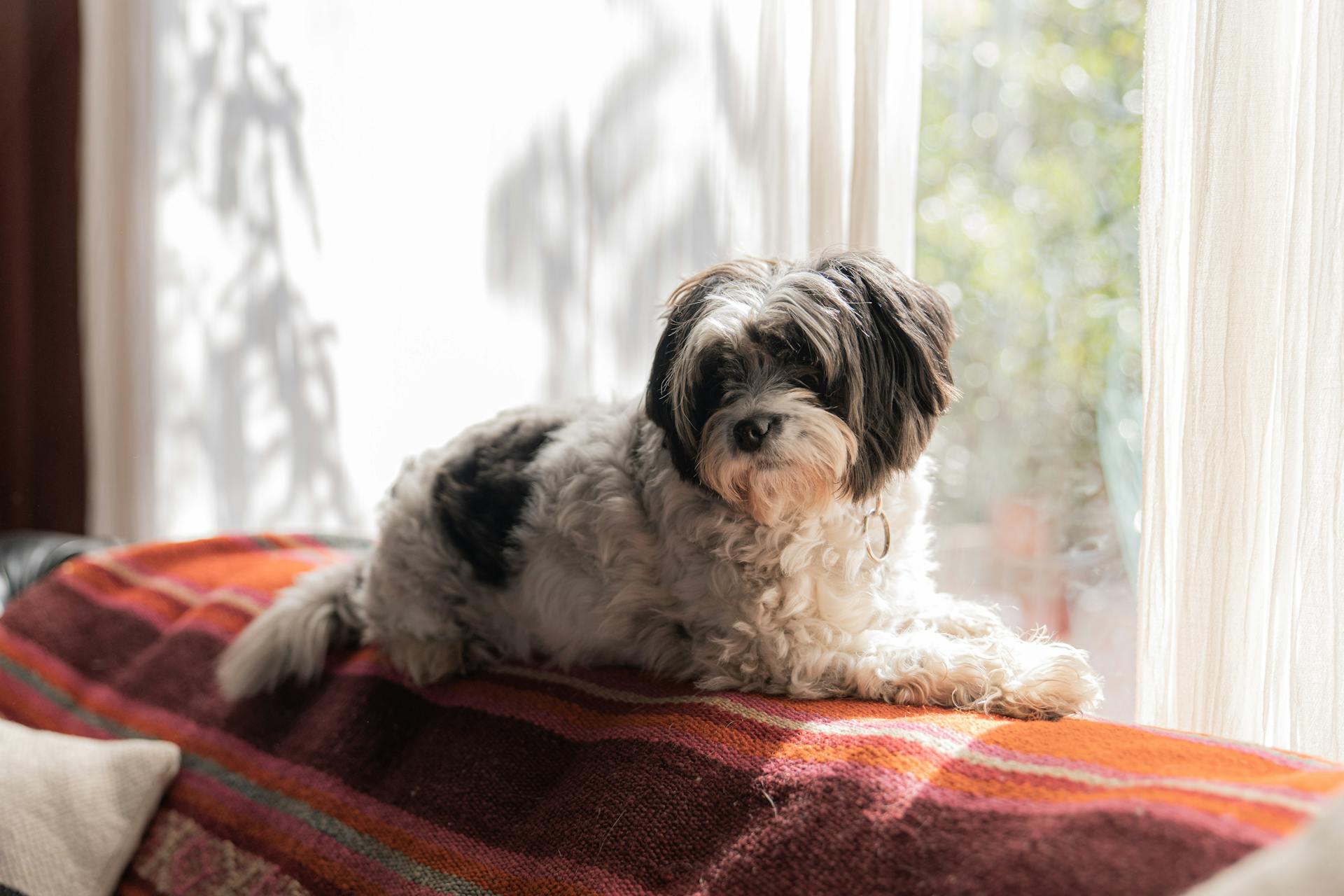
In some cases, your veterinarian may recommend a topical hot spot treatment to protect and soothe any lasting irritation, which should be applied 3-4X daily. Monitoring how often your pet licks or scratches the area is also important, and an e-collar or plastic cone may be necessary if they continue to lick excessively.
Here are some common treatments for hot spots:
- Ear medications for dogs with otitis
- Allergy medicine for dogs (e.g. Apoquel, Cytopoint, etc) to help control seasonal allergies
- Limited ingredient or hypoallergenic diet for dogs with food allergies
- Routine foot or belly wiping for dogs with contact allergies
- Pain medications or natural pain relief for dogs if the hot spot is a sign your dog is in pain
- Flea control for flea-allergic dogs
Treatment Options
The best treatment for Shih Tzu hot spots depends on the underlying source of irritation, and your vet will need to identify the underlying cause to treat it effectively. Your vet may prescribe medication or recommend natural remedies to alleviate itching and speed up the healing process.
If you can't identify the cause, it's best to head to the vet to understand how to help your dog. Natural remedies can be helpful in restoring healthy skin and getting rid of the itch and inflammation, but it's essential to take advice from veterinary professionals.
To treat the hot spot, start by applying a topical hot spot treatment to protect and soothe any lasting irritation. You can also try trimming the fur around the spot using clips or scissors, and cleaning the affected skin area with warm water and mild soap.
Here are some natural remedies that may be helpful in treating hot spots:
- Applying moist tea bags directly to the irritated skin
- Coconut oil
- Aloe vera (ensure any aloe vera-containing products are formulated for dogs and approved by your vet)
- Omega-3 fatty acids for dogs (but remember that seeing the anti-inflammatory and skin-support benefits may take several weeks)
- Calming supplements (may be helpful for anxious dogs who lick themselves a lot)
E-Collar or Shirt
To prevent further irritation and promote healing, you'll need to protect the hot spot from your dog's scratching and licking.
An Elizabethan collar, also known as an E-collar or "cone of shame", is often the best solution to keep your dog from accessing the affected area.
If your dog is using their back paws to scratch the site, a commercial doggy bodysuit, baby onesie, or a loose-fitting T-shirt can be a good alternative to protect the hot spot as it heals.
Curious to learn more? Check out: Dog Shih Tzu
NHV Supplements and Remedies
NHV Supplements and Remedies can be a helpful addition to your dog's treatment plan. If you can easily identify the origin of the hot spot, natural remedies like moist tea bags, coconut oil, and aloe vera (in dog-formulated products) can help soothe the skin and reduce inflammation.
Aloe vera, in particular, can be effective in calming irritated skin, but be sure to choose products specifically formulated for dogs and approved by your vet. Omega-3 fatty acids can also provide anti-inflammatory benefits, although it may take several weeks to see noticeable effects.
Some other natural remedies worth considering are calming supplements, which can help anxious dogs that tend to lick themselves excessively. These supplements can provide relief while you're waiting to see your veterinarian.
Here are some natural remedies to consider:
- Moist tea bags
- Coconut oil
- Aloe vera (in dog-formulated products)
- Omega-3 fatty acids
- Calming supplements
Remember, even if you're using natural remedies, it's essential to consult with your veterinarian to determine the underlying cause of the hot spot and ensure you're using the right treatment. Consistency is key, so be sure to administer any remedy daily according to instructions to prevent hot spots from recurring.
Maintain Care
To maintain care for your Shih Tzu's hot spot, it's essential to keep the affected area clean and dry. Regularly brush and bathe your dog, especially during the summer months, to remove allergens and irritants from their skin and coat.
Daily cleaning and checking of the affected area will help prevent further irritation and promote healing. If the area worsens or doesn't show improvement in a couple of days, contact your veterinarian for further treatment, such as antibiotics.
A balanced diet and proper hydration are also crucial for your dog's overall health and hot spot recovery. Ensure your Shih Tzu is getting enough fatty acids, such as Omega-3, which can help reduce inflammation and promote a healthy skin barrier.
Here are some tips to help you maintain care for your Shih Tzu's hot spot:
- Keep the affected area clean and dry
- Brush and bathe your dog regularly, especially during the summer months
- Use a shampoo that's properly formulated for your dog's coat type and pH balanced for optimal skin health
- Consult with your veterinarian about anti-anxiety medications or environmental enrichment for dogs prone to excessive licking
By following these tips and working closely with your veterinarian, you can help your Shih Tzu recover from a hot spot and prevent future occurrences.
Complications and Costs
Hot spots on Shih Tzus can be a real concern, and if left untreated, they can lead to some serious complications. Skin infections, abscesses, and myiases ("flystrike" or maggots) are all possible outcomes if prompt treatment is not sought.
The cost of treating hot spots can vary greatly depending on the severity of the lesion and how often it recurs. If the lesions are uncomplicated and only appear once or twice a year, treatment costs can range from $40 to $200.
However, if more comprehensive diagnostic tests are required, the expense can increase significantly, potentially reaching up to $2,000 for allergy testing.
Possible Complications
If left untreated, hot spots can lead to some serious complications. One of the most common complications is skin infections, which can be caused by bacterial growth in the affected area.
Skin infections can quickly progress to abscesses, which are painful and potentially life-threatening if not treated promptly. Abscesses are essentially pockets of pus that form on the skin, often as a result of a bacterial infection.
Another possible complication is myiases, also known as "flystrike" or maggots, which can infest the affected area and cause further damage. This is a particularly unpleasant and potentially deadly complication that requires immediate veterinary attention.
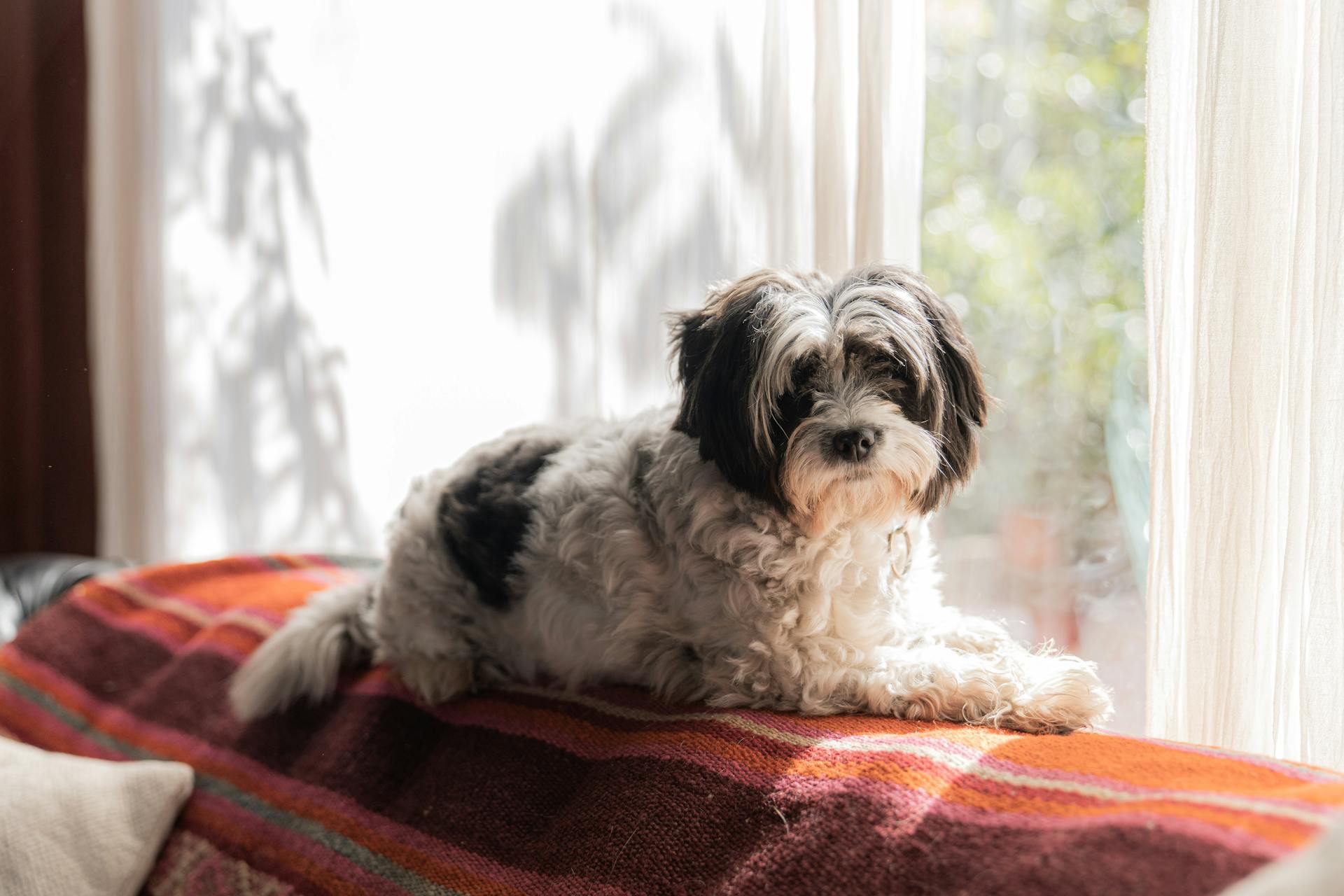
In severe cases, hot spots can even lead to metastases, such as carcinomas, which are types of cancer that have spread to other parts of the body. This is a rare but serious complication that requires prompt and aggressive treatment.
Here are some possible complications of hot spots on dogs:
- Skin Infections
- Abscesses
- Myiases (“flystrike” or maggots)
- Metastases (such as carcinomas)
Dog Treatment Costs
Dog treatment costs can be a significant financial burden, but understanding what to expect can help you prepare.
The cost of treating hot spots on dogs can range from $40 to $200, depending on the severity of the lesion and how often it recurs.
If your dog's hot spots are uncomplicated and occur only once or twice a year, you might be able to treat them symptomatically without breaking the bank.
However, if more comprehensive diagnostic tests are required, the expense can increase significantly, potentially reaching up to $2,000 for allergy testing.
Vet bills can be expensive, but with the right pet insurance policy, you can protect yourself against unexpected costs and ensure your furry friend gets the best care possible.
Frequently Asked Questions
Can I put neosporin on a dog's hot spot?
Yes, Neosporin ointment can be used on a dog's hot spot in small amounts, but make sure your dog doesn't lick it off to avoid any potential harm.
Will hot spots heal on their own?
Hot spots can be challenging for dogs to heal on their own due to their tendency to lick, scratch, or bite at the affected area. Professional veterinary care is often necessary to help hot spots heal and prevent further complications.
How do you treat skin bumps on a Shih Tzu?
Antibiotics or antifungal treatments may be prescribed by a veterinarian to address skin bumps on a Shih Tzu, depending on the underlying cause
What does a hotspot look like on a dog?
A hotspot on a dog typically appears as a red, swollen, and moist area with crusting, matting, or discharge, often found on the hips, limbs, or head. If you suspect your dog has a hotspot, it's essential to seek veterinary attention to prevent further irritation and infection.
Featured Images: pexels.com
